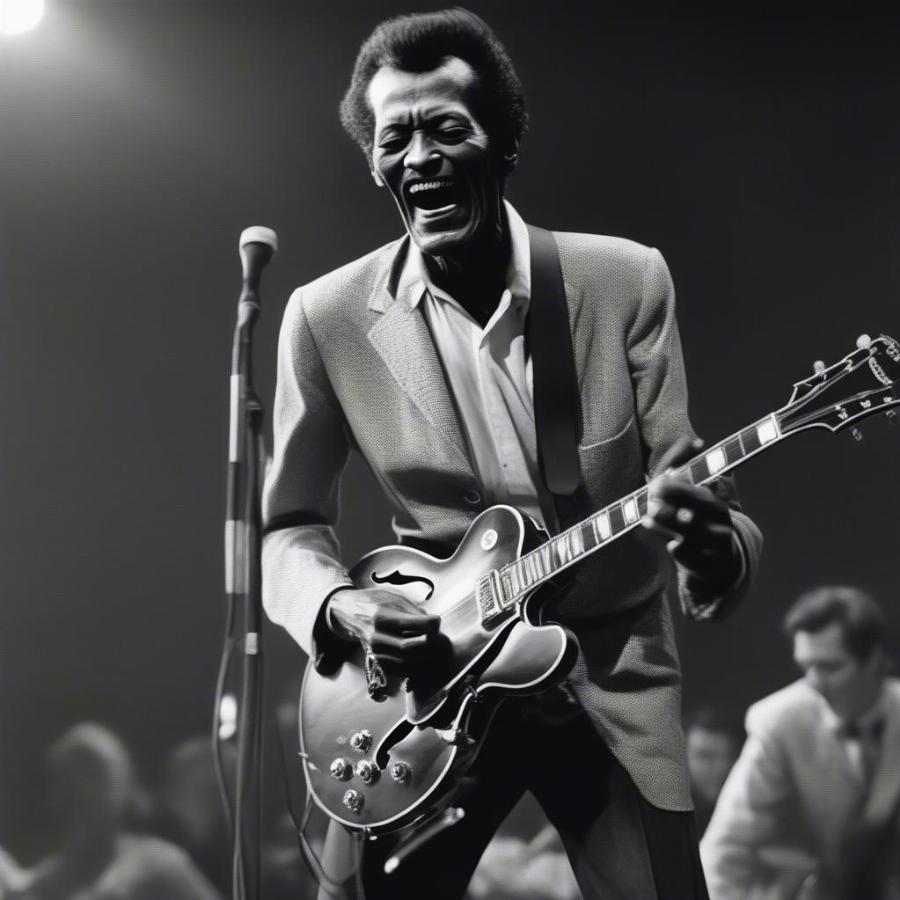Chuck Berry’s Johnny B. Goode: A Rock and Roll Anthem from 1955

Johnny B. Goode, released in 1955, quickly became Chuck Berry’s signature song and a cornerstone of rock and roll. It’s a high-energy track that tells the story of a country boy with a dream of musical stardom. The song’s infectious guitar riff, driving rhythm, and relatable lyrics resonated with audiences then and continue to inspire generations of musicians today. It’s a testament to the power of rock and roll and Chuck Berry’s innovative genius.
The Genesis of Johnny B. Goode: From Country Roots to Rock and Roll Fame
The inspiration for Johnny B. Goode came from a variety of sources, blending Chuck Berry’s personal experiences with his keen observations of the world around him. While the song’s protagonist is often thought to be autobiographical, Berry has stated that the character was initially inspired by Johnnie Johnson, his longtime piano player. However, Berry did incorporate elements of his own life story, such as his rural upbringing and desire to achieve musical success. He replaced Johnnie with Johnny, acknowledging Johnson’s influence while crafting a character that would resonate with a wider audience.
The song’s setting, “down in Louisiana, close to New Orleans,” is a nod to the rich musical heritage of the region, a place where blues, country, and R&B intertwined. This blend of influences is evident in Johnny B. Goode itself, a song that fuses country guitar licks with a rock and roll beat.
The Impact of Johnny B. Goode: A Cultural Touchstone
Johnny B. Goode’s impact extends far beyond its initial release. It has been covered by countless artists, featured in numerous films and television shows, and even selected by NASA to be included on the Voyager Golden Record, a time capsule of Earth’s sounds and images sent into interstellar space. This speaks volumes about the song’s universal appeal and its enduring legacy as a cultural touchstone.
The Guitar Riff: An Instantly Recognizable Icon
One of the most defining features of Johnny B. Goode is its iconic guitar riff. Instantly recognizable, it’s a testament to Chuck Berry’s innovative guitar playing and his ability to create music that transcends generations. The riff’s infectious energy and unique blend of blues and country influences has inspired countless guitarists and solidified its place as one of the most famous riffs in rock and roll history.

The Lyrics: A Story of Dreams and Ambition
The lyrics of Johnny B. Goode tell a compelling story of a young man with a burning desire to escape his humble beginnings and achieve musical stardom. Johnny, a country boy who “never learned to read or write so well, but he could play a guitar just as well as ringing a bell,” embodies the spirit of rock and roll rebellion and the pursuit of dreams against all odds. His journey resonates with listeners who aspire to achieve greatness, regardless of their background.
The Legacy of Chuck Berry and Johnny B. Goode
Chuck Berry’s Johnny B. Goode stands as a testament to his pioneering role in shaping the landscape of rock and roll. The song’s enduring popularity, its cultural significance, and its influence on subsequent generations of musicians solidify Berry’s place as a true icon of the genre. Johnny B. Goode isn’t just a song; it’s a piece of rock and roll history.
chuck berry and jerry lee lewis
Johnny B. Goode’s Influence on Popular Culture
The song’s influence has permeated popular culture, appearing in films like “Back to the Future,” where Marty McFly performs a scorching rendition, and inspiring countless covers by artists across diverse genres. This widespread recognition underscores Johnny B. Goode’s enduring appeal and its ability to connect with audiences across generations and cultural boundaries.

The Musical Structure: A Blueprint for Rock and Roll
The song’s structure, characterized by its driving rhythm, memorable guitar riff, and storytelling lyrics, became a blueprint for countless rock and roll songs that followed. It established a formula that helped define the genre and influenced the way rock and roll music was written, performed, and experienced.
The Enduring Appeal: Why Johnny B. Goode Remains Relevant
Decades after its release, Johnny B. Goode continues to resonate with listeners, its timeless themes of ambition, dreams, and the power of music remaining as relevant today as they were in 1955. The song’s raw energy and infectious spirit continue to inspire, proving that great music transcends time and cultural boundaries.

Conclusion: A Timeless Anthem of Rock and Roll
Chuck Berry’s Johnny B. Goode, released in 1955, remains a timeless anthem of rock and roll, its influence continuing to reverberate through the music world and popular culture. The song’s infectious energy, relatable story, and iconic guitar riff have made it a cultural touchstone, inspiring generations of musicians and solidifying Chuck Berry’s legacy as a true pioneer of rock and roll.
FAQ:
- When was Johnny B. Goode released? Johnny B. Goode was released in 1955.
- Who wrote Johnny B. Goode? Chuck Berry wrote and performed Johnny B. Goode.
- What inspired Johnny B. Goode? Chuck Berry’s piano player, Johnnie Johnson, and Berry’s own experiences inspired the song.
- Why is Johnny B. Goode so famous? Its catchy riff, relatable lyrics, and high energy made it a hit.
- What movie features Johnny B. Goode? “Back to the Future” prominently features the song.
- What is the meaning of Johnny B. Goode? It’s a story about a country boy with dreams of musical stardom.
- Who is Johnny B. Goode based on? While partly autobiographical, it’s primarily based on Johnnie Johnson.
- What is the significance of the guitar riff in Johnny B. Goode? It’s one of the most recognizable and influential riffs in rock and roll history.
- Why is Johnny B. Goode considered a rock and roll anthem? It embodies the spirit and energy of the genre, influencing countless musicians and remaining popular for decades.




